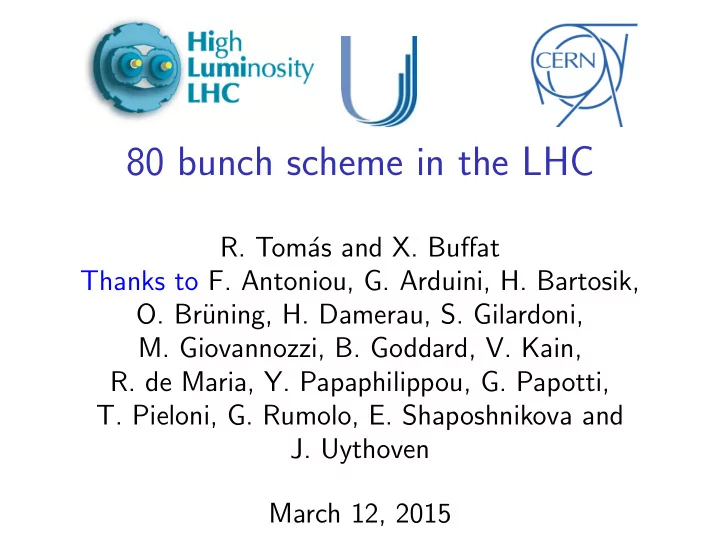

80 bunch scheme in the LHC R. Tom´ as and X. Buffat Thanks to F. Antoniou, G. Arduini, H. Bartosik, O. Br¨ uning, H. Damerau, S. Gilardoni, M. Giovannozzi, B. Goddard, V. Kain, R. de Maria, Y. Papaphilippou, G. Papotti, T. Pieloni, G. Rumolo, E. Shaposhnikova and J. Uythoven March 12, 2015
Turn-around time Since Chamonix 2014 HL-LHC beams need a 7.2s longer SPS ramp (E. Shaposhnikova): G. Arduini et al – 23’ � 28’ @ inj. — 183’ Maybe 80 bunch scheme helps with turn-around-time
80 bunch scheme and 4 PS batch trains 8 non-colliding bunches (min?) Train gap 950ns (min 900ns) P ✐ P � ✒ P First train in the LHC � P P P � P ✱ ✁ ✱ ✁ ✱ ✁ ✱ ✱ ✁ ✱ ✁ ✱ ✁ ✱ Abort gap 110 slots ✁ Full LHC ✱ ❍❍❍❍ ✁ ✱ ❍ ❥ (120 9 × 4 × 80=2880 if 3 nc bunches)
Comparing to nominal (colliding bunches) # IP1&5 IP2 IP8 Abort Non- #SPS gap Coll. inj 72 2736 2452 2524 120 12 12 72 + 2808 2276 2232 120 12 11 80 2800 2727 2694 110 8 12 80 + 2880 2380 2366 110 8 10 If 3 non-colliding bunches OK, abort gap=120 OK. Else train gap can be shorter by 2 slots (950 → 900ns) Saving 2 SPS injections shortens turn-around-time (183’ → 178’) and decreases IBS emittance growth by ≈ 1% in first trains.
Comparing to nominal (luminosity) # IP1&5 IP2 IP8 Abort Non- #SPS extra ≈ 0.5% from TAT not included gap Coll. inj 72 2736 2452 2524 120 12 12 72 + +2.6% -7.2% -11% 120 12 11 80 +2.3% +11% +6.7% 110 8 12 80 + +5.2% -3% -6.2% 110 8 10 ✲ With 80 everybody wins Does IP2 want it? 80 + is optimized for IP1&5 Is 80 + OK for LHCB? → Need input
How to find the optimum? 3 PS batch types: 72, 80, 81 SPS trains made of 1,2,3 or 4 PS batches (120 different SPS trains) with ≈ 10 possible train gaps (900-1150ns) and between 10 and 15 SPS injections This gives about 10 40 possible LHC filling schemes (symmetries are used to find good combinations)
Long ranges in Nominal ✛ Non-colliding bunches
Long ranges in 80 + ✛ Non-colliding bunches No differences other than fewer non-colliding bunches is better
80 bunches/4 trains merits and issues Merits: ⋆ 5.2% more luminosity in IP1&5 (same pile-up) ⋆ with room for compromises with other IPs ⋆ Possibly faster turn-around ⋆ Potential to be a scrubbing beam Issues: ⋆ SPS to LHC transfer with 4 × 80=320 bunches instead of 4 × 72=288 ⋆ Injection protection devices (TDI, TCDI, etc) need to “survive” the extra charge ⋆ ≈ 10% larger heat load due to e-cloud
Pushed 8b+4e Merits: ⋆ 7 PSB bunches can provide 56 × 4 × 9 =2016 bunches in the LHC ⋆ Considerably lower e-cloud than 25 ns baseline ⋆ Larger lumi than 50 ns or plain 8b+4e ⋆ Smaller β ∗ and smaller crossing angle thanks to fewer long ranges. Issues: ⋆ Lower luminosity than baseline ⋆ with 10% more peak pile-up
Pushed 8b+4e Nominal T. Pieloni 8b+4e C. Tambasco 30% fewer LRs Lower number of long range encounters allows for smaller crossing angle and smaller β ∗ ( β ∗ = 10cm, θ = 530 µ m (9 σ ) with crab cavities in the following )
Pushed 8b+4e: Performance I (preliminary) more IBS 2.4 3 3 ✄ 2.2 ✄ 2.8 2.8 2 ppb [10 11 ] ε x [10 -6 m] ✄ ε y [10 -6 m] ✄ ✎ 1.8 2.6 2.6 1.6 2.4 2.4 1.4 1.2 2.2 2.2 1 2 2 0.8 0.6 1.8 1.8 0 2 4 6 8 10 0 2 4 6 8 10 0 2 4 6 8 10 US2 Time [h] Time [h] Time [h] 8b4e 0.8 0.8 0.8 0.7 0.7 0.6 0.6 σ z [dm] β x [m] β y [m] 0.5 0.5 0.4 0.4 lower β ∗ 0.3 0.3 0.2 0.2 0.7 0.1 0.1 0 2 4 6 8 10 0 2 4 6 8 10 0 2 4 6 8 10 Time [h] Time [h] Time [h]
Pushed 8b+4e: Performance II (preliminary) ✗✔ lower leveled lumi same pile-up more peak pile-up 5.5 1.5 1.4 ✄ ✄ ✄ ✎ L [10 34 cm -2 s -1 ] ✄ 5 ✖✕ 1.4 1.3 µ peak [mm -1 ] ✄ 4.5 µ [100] 1.3 1.2 ✄ ✎ ✄ 4 1.2 1.1 3.5 1.1 1 3 2.5 1 0.9 0 2 4 6 8 10 0 2 4 6 8 10 0 2 4 6 8 10 larger ✗✔ US2 Time [h] tuneshift Time [h] Time [h] 8b4e lower performance -22% ❈ 3 ✖✕ ❈ 3.5 3.5 L int [100fb -1 y -1 ] 2.5 ❈ ❈ ❲ ξ x [0.01] ξ y [0.01] 2 3 3 1.5 2.5 2.5 1 2 2 0.5 0 1.5 1.5 0 2 4 6 8 10 0 2 4 6 8 10 0 2 4 6 8 10 Time [h] Time [h] Time [h]
Conclusions ⋆ 80 bunch scheme is promissing for performance and flexibility: up to 5.2% in lumi, turn-around-time, scrubbing beam, 80bunch/3batches, etc ⋆ Experimentally not yet demonstrated ⋆ and full LHC potential not yet explored ⋆ Need to know: minimum number of non-colliding bunches, figure of merit for luminosities in the IPs and abort gap margin. ⋆ Risk of protection devices to be assessed.
Recommend
More recommend